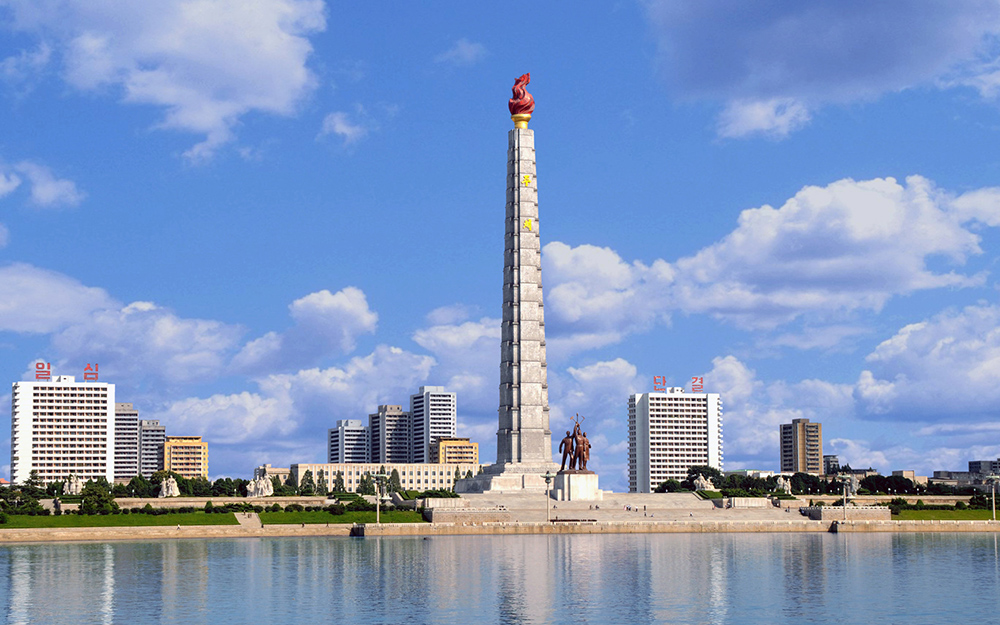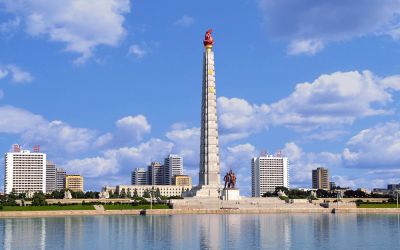

The Juche Tower in Pyongyang is one of the most iconic landmarks of North Korea, symbolizing the Juche ideology developed by Kim Il-sung, the country's first leader. The activity includes an elevator ride up to the tower's observation deck, located approximately 150 meters above ground. Visitors can enjoy a panoramic view of the entire city of Pyongyang, which includes a unique perspective of landmarks such as the Taedong River, Kim Il-sung Square, and the distant Pyongyang skyline. The experience offers a chance to take breathtaking photos and gain insights into North Korean architecture and urban planning. Knowledgeable guides often accompany visitors, providing historical context and answering questions about the tower and the city. The duration of this activity typically lasts around 30 minutes to 1 hour, allowing ample time to soak in the views and learn about the significance of the Juche ideology.
Engaging in a guided tour of the Juche Tower is an enriching experience for those interested in the political history and culture of North Korea. The tour generally starts with an introduction to the Juche philosophy, which emphasizes self-reliance and independence in all aspects of state governance and personal life. Travelers are then taken through various exhibits that showcase North Korea's achievements and milestones. They may also see representations of the Juche idea in art and multimedia presentations. The experience is often both educational and ideological, as guides explain the principles of Juche and how they have shaped the nation. Besides, visitors can admire the tower’s architecture, featuring 25,550 granite blocks representing each day of Kim Il-sung’s life up to his 70th birthday. The tour duration usually ranges from 1 to 2 hours, including the time spent at the observation deck.
A lesser-known but quite dramatic activity at the Juche Tower is witnessing the Flame of the Tower lighting ceremony. This ceremonial event is not always open to the public and can be exclusive to national holidays or significant political anniversaries. The experience offers a glimpse into North Korean national pride and reverence for their Juche ideology. The tower is capped with a flickering red flame, made of glass and illuminated with internally lit lamps, symbolizing the eternal life of the Juche ideology. Observers can witness the ceremony, which features a series of performances, speeches, and, finally, the lighting of the flame itself. It is both a cultural spectacle and a deeply political event, filled with pageantry and symbolism. Duration for the ceremony may range from 30 minutes to over an hour, depending on the occasion and the official festivities planned for the day.
The Juche Tower is nested in a beautifully landscaped park, complete with statutes, fountains, and seating areas where visitors can relax and reflect on the imprints of Juche philosophy on North Korean society. Walking through this park provides a unique opportunity to observe everyday life in Pyongyang, as local residents also enjoy the serene environment this park offers. Statues depicting workers, farmers, and intellectuals highlight the importance of each group in the advancement of Juche ideology. The leisurely stroll typically takes about 30 minutes to an hour, allowing visitors to take in the carefully curated propaganda arts and monuments, providing a deeper understanding of the regime's attempts to integrate political messages into public spaces.
Photography enthusiasts can partake in a photography session at the Juche Tower and its surroundings, capturing the grandeur of the monument and the daily life in Pyongyang that revolves around it. Several vantage points offer a variety of angles and compositions, from the tower against the skyline to close-up details of the tower’s architecture and the surrounding sculptures. A professional photography session may last anywhere between 1 to 3 hours, providing ample time to wait for the perfect light and capture images of this important North Korean symbol. Sessions are often framed by the guide’s instructions on what can and cannot be photographed, relevant both for personal safety and adherence to local regulations. Despite these restrictions, such a session can yield a fascinating portfolio of images that speak volumes about the country’s culture and ideology.
Often offered to foreign visitors with a deep interest in North Korean ideology, attending a Juche Idea workshop or lecture within the Juche Tower complex can be quite an experience. These workshops are characterized by presentations and discussions on the principles of the Juche philosophy and its application in the social, economic, and political landscape of North Korea. While participants should be aware that the content of these sessions are heavily influenced by the state's narrative, they offer a unique chance to engage with North Korean educators and occasionally, fellow enthusiasts from around the world. Such a workshop might last 2 to 3 hours, including a question-and-answer session that must be navigated carefully, given the sensitive nature of political discourse in North Korea.
Exclusive and rare to experience, the Juche Tower light show is an awe-inspiring display of lights, music, and possibly even coordinated drone performances. Though not a regular event, when it does occur, typically on special national occasions, the light show turns the night sky into a canvas that celebrates the achievements and ideologies of North Korea. The light show can be seen from various parts of the city, but the best views are certainly from the areas immediately surrounding the tower. The display itself is usually short, about 20 to 30 minutes, but it is recommended to arrive early and secure a good viewing spot. Keep in mind the schedules and access can be extremely erratic, and participation as a foreigner may be subject to approval from tour guides or government minders.
Visitors with a profound interest in North Korean history and culture might opt for a study session held within the tower's premises. These educational experiences are designed to deepen the understanding of North Korea’s past, its values, and the growth of the Juche idea. Not your average tour activity, these intense study sessions could span several hours and delve into detailed discussions on North Korean historical narratives, often focusing on the anti-imperialist struggle, the leadership of the Kim family, and the development of the Workers' Party of Korea. Usually facilitated by an English-speaking North Korean guide or historian, these study sessions are carefully curated to align with the government's perspective but nonetheless provide a closer look at the ideologies that shape the nation. Sessions can last from 2 to 4 hours, including a series of lectures, documentary viewings, and controlled Q&A sessions.
Occasionally, the Juche Tower may offer a dining experience that combines North Korean cuisine with spectacular views of Pyongyang from its high vantage point. While not a standard offering, this special activity would allow a small number of visitors to enjoy a traditional Korean meal in an exclusive setting surrounded by political history and the city's landscape. The dinner itself may feature local delicacies, such as cold noodles (Naengmyeon), Kimchi, and other regional specialties, providing a taste of North Korean culture. The duration of the dinner could be approximately 2 hours, factoring in the multi-course meal and the time allowed for savoring the views and atmosphere. Keep in mind that such experiences are unique and might only be accessible through government-sanctioned tours or on special occasions.
Near the Juche Tower, the Revolutionary Martyrs' Cemetery offers a solemn and educational activity. The cemetery is dedicated to Korean revolutionaries who fought against Japanese colonial rule. The visit includes a guided tour through the beautifully maintained grounds and an explanation of the significance of the individuals memorialized, many of whom were part of the anti-Japanese resistance movement, Korean War, or early political history of the DPRK. The statues and monuments offer a somber reminder of the sacrifices made and serve as a tool for the regime to continue to inspire a sense of nationalism and loyalty among citizens. A visit to the cemetery usually lasts around 1 hour, affording time for reflection and gaining a deeper understanding of how history and ideology are interwoven in North Korean society.
